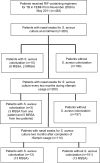Characterization of rifampin-resistant Staphylococcus aureus nasal carriage in patients receiving rifampin-containing regimens for tuberculosis
- PMID: 30147345
- PMCID: PMC6098419
- DOI: 10.2147/IDR.S163634
Characterization of rifampin-resistant Staphylococcus aureus nasal carriage in patients receiving rifampin-containing regimens for tuberculosis
Abstract
Objectives: This study investigated molecular characteristics of rifampin (RIF)-resistant (RIF-R) Staphylococcus aureus isolates recovered from patients receiving RIF-containing regimens for tuberculosis (TB).
Patients and methods: Patients with TB who received RIF-containing regimens from November 2009 to May 2011 at a medical center were enrolled. Nasal swabs for S. aureus culture were obtained at the time of enrollment, and then every two months until two months after RIF treatment had been completed. Genetic relatedness of the isolates was determined using pulsed-field gel electrophoresis, multilocus sequence typing, and gene typing of spa and SCCmec. The presence of RIF resistance-associated mutations in rpoB, and fusidic acid resistance genes fusB and fusC in the S. aureus isolates were analyzed.
Results: Among the 200 patients enrolled in this study, 152 completed follow-ups during treatment, and 114 completed two months of follow-up after discontinuing use of RIF. At enrollment, ten patients (5%) had nasal colonization with S. aureus, namely eight with methicillin-susceptible S. aureus (MSSA), and two with methicillin-resistant S. aureus (MRSA, ST59-SCCmecIV-RIF-susceptible). All these patients were decolonized after RIF usage. Two patients with MSSA colonization at enrollment showed recolonization with genetically unrelated MSSA strains two months after completion of RIF treatment. There were five ST45-SCCmecVT-RIF-R strains from two patients isolated during RIF exposure. Sequencing of rpoB in the RIF-R S. aureus isolates revealed different mutation sites between the MSSA and MRSA isolates.
Conclusion: RIF-R S. aureus strains are more likely to result in persistent nasal carriage in TB patients receiving RIF treatment. Monitoring of emergence and possible dissemination of the MRSA ST45 strains among TB patients treated with RIF in Taiwan is warranted.
Keywords: Staphylococcus aureus; Taiwan; methicillin-resistant S. aureus; nasal carriage; rifampin resistance; tuberculosis.
Conflict of interest statement
Disclosure The authors report no conflicts of interest in this work.
Figures

Similar articles
-
Molecular Characteristics and Prevalence of Rifampin Resistance in Staphylococcus aureus Isolates from Patients with Bacteremia in South Korea.Antibiotics (Basel). 2023 Oct 4;12(10):1511. doi: 10.3390/antibiotics12101511. Antibiotics (Basel). 2023. PMID: 37887212 Free PMC article.
-
Molecular Characteristics of Rifampin-Sensitive and -Resistant Isolates and Characteristics of rpoB Gene Mutations in Methicillin-Resistant Staphylococcus aureus.Infect Drug Resist. 2021 Nov 4;14:4591-4600. doi: 10.2147/IDR.S336200. eCollection 2021. Infect Drug Resist. 2021. PMID: 34764656 Free PMC article.
-
Molecular typing and characterization of nasal carriage and community-onset infection methicillin-susceptible Staphylococcus aureus isolates in two Taiwan medical centers.BMC Infect Dis. 2012 Dec 10;12:343. doi: 10.1186/1471-2334-12-343. BMC Infect Dis. 2012. PMID: 23228040 Free PMC article.
-
Fusidic acid resistance determinants in Staphylococcus aureus clinical isolates.Antimicrob Agents Chemother. 2010 Dec;54(12):4985-91. doi: 10.1128/AAC.00523-10. Epub 2010 Sep 20. Antimicrob Agents Chemother. 2010. PMID: 20855746 Free PMC article.
-
Prevalence and molecular characteristics of methicillin-resistant Staphylococcus aureus among nasal carriage strains isolated from emergency department patients and healthcare workers in central Taiwan.J Microbiol Immunol Infect. 2019 Apr;52(2):248-254. doi: 10.1016/j.jmii.2018.08.015. Epub 2018 Sep 15. J Microbiol Immunol Infect. 2019. PMID: 30292763
Cited by
-
Molecular Characterization of Rifampicin-Resistant Staphylococcus aureus Isolates from Retail Foods in China.Antibiotics (Basel). 2021 Dec 4;10(12):1487. doi: 10.3390/antibiotics10121487. Antibiotics (Basel). 2021. PMID: 34943699 Free PMC article.
-
Molecular Characteristics and Prevalence of Rifampin Resistance in Staphylococcus aureus Isolates from Patients with Bacteremia in South Korea.Antibiotics (Basel). 2023 Oct 4;12(10):1511. doi: 10.3390/antibiotics12101511. Antibiotics (Basel). 2023. PMID: 37887212 Free PMC article.
-
The global prevalence of fusidic acid resistance in clinical isolates of Staphylococcus aureus: a systematic review and meta-analysis.Antimicrob Resist Infect Control. 2021 May 1;10(1):75. doi: 10.1186/s13756-021-00943-6. Antimicrob Resist Infect Control. 2021. PMID: 33933162 Free PMC article.
-
Staph wars: the antibiotic pipeline strikes back.Microbiology (Reading). 2023 Sep;169(9):001387. doi: 10.1099/mic.0.001387. Microbiology (Reading). 2023. PMID: 37656158 Free PMC article. Review.
-
Staphylococcal Drug Resistance: Mechanisms, Therapies, and Nanoparticle Interventions.Infect Drug Resist. 2025 Feb 19;18:1007-1033. doi: 10.2147/IDR.S510024. eCollection 2025. Infect Drug Resist. 2025. PMID: 39990781 Free PMC article. Review.
References
-
- Deresinski S. Vancomycin in combination with other antibiotics for the treatment of serious methicillin-resistant Staphylococcus aureus infections. Clin Infect Dis. 2009;49(7):1072–1079. - PubMed
-
- Tang HJ, Lai CC, Hsueh PR, et al. RNA polymerase B subunit gene mutations in biofilm-embedded methicillin-resistant Staphylococcus aureus following rifampin treatment. J Microbiol Immunol Infect. 2016;49(3):394–401. - PubMed
-
- Russell CD, Lawson McLean A, Saunders C, Laurenson IF. Adjunctive rifampicin may improve outcomes in Staphylococcus aureus bacteraemia: a systematic review. J Med Microbiol. 2014;63(Pt 6):841–848. - PubMed
-
- Sekiguchi J, Fujino T, Araake M, et al. Emergence of rifampicin resistance in methicillin-resistant Staphylococcus aureus in TB wards. J Infect Chemother. 2006;12(1):47–50. - PubMed
LinkOut - more resources
Full Text Sources
Other Literature Sources

